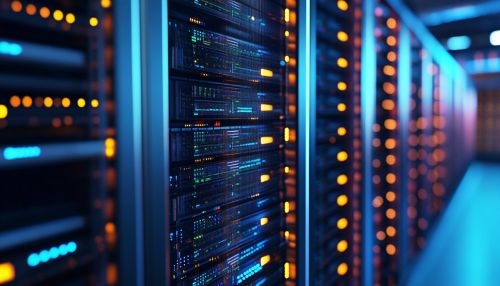Inference engine: Difference between revisions
(Created page with "== Introduction == An inference engine is a core component of an expert system, a form of artificial intelligence that applies logical rules to a knowledge base to deduce new information or make decisions. These systems are designed to simulate human reasoning and are used in various applications, from medical diagnosis to financial forecasting. The inference engine interprets and evaluates the knowledge stored in the system...") |
No edit summary |
||
| Line 43: | Line 43: | ||
* **Robotics**: Inference engines are used to control robotic systems by interpreting sensor data and making decisions based on predefined rules. | * **Robotics**: Inference engines are used to control robotic systems by interpreting sensor data and making decisions based on predefined rules. | ||
[[Image:Detail-98333.jpg|thumb|center|A modern computer server room with rows of servers and blinking lights, representing the computational power behind inference engines.|class=only_on_mobile]] | |||
[[Image:Detail-98334.jpg|thumb|center|A modern computer server room with rows of servers and blinking lights, representing the computational power behind inference engines.|class=only_on_desktop]] | |||
== Challenges and Limitations == | == Challenges and Limitations == | ||
Latest revision as of 08:29, 9 October 2024
Introduction
An inference engine is a core component of an expert system, a form of artificial intelligence that applies logical rules to a knowledge base to deduce new information or make decisions. These systems are designed to simulate human reasoning and are used in various applications, from medical diagnosis to financial forecasting. The inference engine interprets and evaluates the knowledge stored in the system's database, applying rules and logic to provide solutions or insights.
Historical Background
The development of inference engines dates back to the early days of artificial intelligence research in the 1960s and 1970s. The pioneering work in this field was driven by the need to create systems that could mimic human decision-making processes. Early systems, such as MYCIN, were developed to assist in medical diagnosis by applying a set of rules to a database of symptoms and diseases. These systems laid the groundwork for modern inference engines, which have become more sophisticated with advances in computing power and algorithms.
Components of an Inference Engine
An inference engine typically comprises several key components:
- **Knowledge Base**: This is a collection of facts and rules about a specific domain. The knowledge base is often represented using propositional logic or predicate logic.
- **Working Memory**: This is a dynamic database that stores information about the current state of the system. It is updated as the inference engine processes rules and deduces new information.
- **Rule Interpreter**: This component applies logical rules to the knowledge base and working memory. It uses algorithms to determine which rules are applicable and in what order they should be applied.
- **Control Strategy**: This defines the order in which rules are evaluated and applied. Common strategies include forward chaining and backward chaining, each with its own advantages and applications.
Types of Inference Engines
Inference engines can be classified based on their control strategies:
Forward Chaining
Forward chaining is a data-driven approach where the inference engine starts with the available data and applies rules to infer new data until a goal is reached. This method is often used in systems where all possible conclusions need to be derived from a given set of facts. It is particularly useful in real-time systems where immediate responses are required.
Backward Chaining
Backward chaining is a goal-driven approach where the inference engine starts with a goal and works backward to determine which facts must be true to achieve that goal. This method is commonly used in diagnostic systems, where the goal is to identify the cause of a problem based on observed symptoms.
Applications of Inference Engines
Inference engines are used in a wide range of applications, including:
- **Medical Diagnosis**: Systems like MYCIN and DENDRAL use inference engines to diagnose diseases and recommend treatments based on patient data.
- **Financial Analysis**: Inference engines are used to analyze market trends and make investment decisions by applying rules to financial data.
- **Natural Language Processing**: Inference engines help in understanding and generating human language by applying linguistic rules to text data.
- **Robotics**: Inference engines are used to control robotic systems by interpreting sensor data and making decisions based on predefined rules.


Challenges and Limitations
Despite their capabilities, inference engines face several challenges:
- **Complexity**: As the number of rules and facts increases, the complexity of the inference process can become overwhelming, leading to longer processing times and increased resource consumption.
- **Ambiguity**: Inference engines may struggle with ambiguous or incomplete data, leading to incorrect or uncertain conclusions.
- **Scalability**: Scaling inference engines to handle large datasets or complex domains can be difficult, requiring significant computational resources and optimization.
- **Maintenance**: Keeping the knowledge base up-to-date with accurate and relevant information is a continuous challenge, especially in rapidly changing fields.
Future Directions
The future of inference engines lies in their integration with other AI technologies, such as machine learning and deep learning. By combining rule-based reasoning with data-driven approaches, inference engines can become more adaptive and capable of handling complex, dynamic environments. Additionally, advances in quantum computing may provide new opportunities for optimizing inference processes, enabling faster and more efficient decision-making.
